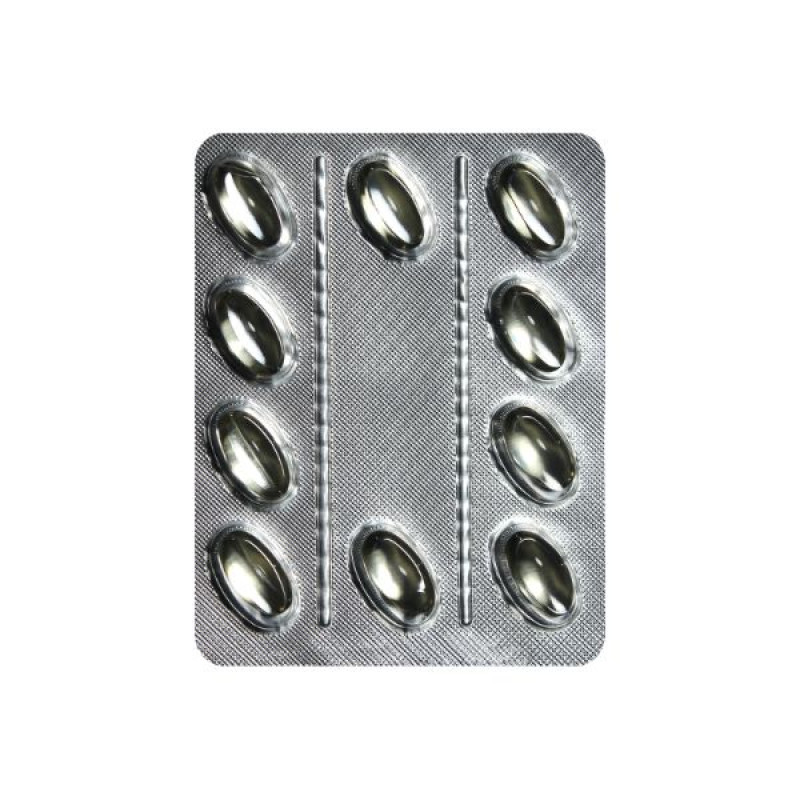Ibufen Junior soft capsules 200 mg blister No. 10

Instructions for Ibufen Junior soft capsules 200 mg blister No. 10
Composition
active ingredient: ibuprofen;
1 soft capsule contains 200 mg of ibuprofen;
excipients: macrogol 600 (E 1521), potassium hydroxide (E 525), purified water;
Gelatin capsule: liquid maltitol (E 965), non-crystallizing sorbitol solution (E 420), gelatin (E 441), patented blue dye (E 131), purified water.
Dosage form
Soft capsules.
Main physicochemical properties: Oval-shaped soft gelatin capsules with a translucent blue shell, containing a viscous liquid.
Pharmacotherapeutic group
Nonsteroidal anti-inflammatory and antirheumatic drugs. Propionic acid derivatives. ATC code M01A E 01.
Pharmacological properties
Pharmacodynamics
Ibuprofen is a derivative of propionic acid. It has analgesic, antipyretic, and anti-inflammatory effects.
The mechanism of action of ibuprofen is primarily due to the inhibition of prostaglandin biosynthesis by reducing the activity of cyclooxygenase (COX), an enzyme that regulates the conversion of arachidonic acid into prostaglandins, prostacyclin and thromboxane. At the same time, as a result of irreversible inhibition of the cyclooxygenase pathway of arachidonic acid metabolism, the formation of prostaglandins is reduced. A decrease in the concentration of prostaglandins at the site of inflammation is accompanied by a decrease in the formation of bradykinin, endogenous pyrogens, other biologically active substances, oxygen radicals and NO. All this leads to a decrease in the activity of the inflammatory process (anti-inflammatory effect of ibuprofen) and is accompanied by a decrease in pain perception (analgesic effect). A decrease in the concentration of prostaglandins in the cerebrospinal fluid leads to the normalization of body temperature (antipyretic effect).
Pharmacokinetics
Ibufen® Junior soft gelatin capsules contain ibuprofen in liquid form. The gelatin capsule provides high accuracy in dosing the substances contained in them. The capsule shell protects the active ingredient from light, air and moisture, and also masks the unpleasant taste and smell of the medicinal substance when taken. The capsule dissolves in the gastrointestinal tract (GI) faster than dragees and tablets, and its liquid contents are absorbed faster and more easily in the human body, ensuring high bioavailability of ibuprofen.
After oral administration, more than 80% of ibuprofen is absorbed from the gastrointestinal tract. 90% of the drug binds to blood plasma proteins (mainly albumin).
The period of reaching the maximum concentration in blood plasma when taken on an empty stomach is 45 minutes, when taken after a meal - 1.5-2.5 hours; in synovial fluid - 2-3 hours, where higher concentrations are created than in blood plasma.
The drug does not accumulate in the body.
Ibuprofen is metabolized mainly in the liver. It undergoes presystemic and postsystemic metabolism. After absorption, about 60% of the pharmacologically inactive R-form of ibuprofen is slowly transformed into the active S-form.
60 - 90% of the drug is excreted by the kidneys in the form of metabolites and products of their binding with glucuronic acid, to a lesser extent - with bile, and no more than 1% is excreted unchanged. After taking a single dose, the drug is completely excreted within 24 hours.
Indication
Symptomatic treatment of headaches, including migraines, toothaches, dysmenorrhea, neuralgia, back pain, joint pain, muscle pain, rheumatic pain, as well as symptoms of colds and flu.
Contraindication
· Hypersensitivity to ibuprofen or to any of the components of the drug.
Hypersensitivity reactions (e.g. asthma, rhinitis, angioneurotic oedema or urticaria) previously observed after taking ibuprofen, acetylsalicylic acid (aspirin) or other NSAIDs.
· Gastric ulcer/bleeding in active form or history of recurrence (two or more severe episodes of ulcer or bleeding).
· History of gastrointestinal bleeding or perforation associated with the use of NSAIDs.
Severe liver or kidney dysfunction; heart failure.
· Last trimester of pregnancy.
Cerebrovascular or other bleeding.
· Disorders of hematopoiesis or blood clotting.
· Dehydration caused by vomiting, diarrhea, or insufficient fluid intake.
Interaction with other medicinal products and other types of interactions
Ibuprofen, like other NSAIDs, should not be used in combination with:
- aspirin, as this may increase the risk of adverse reactions, except when aspirin (dose not exceeding 75 mg per day) has been prescribed by a doctor;
- other NSAIDs, including selective cyclooxygenase-2 inhibitors.
Ibuprofen should be used with caution in combination with:
Antihypertensives (ACE inhibitors and angiotensin II antagonists) and diuretics: NSAIDs may reduce the effect of diuretics and other antihypertensive drugs. In some patients with impaired renal function (e.g. dehydrated patients or elderly patients with compromised renal function), the concomitant use of an ACE inhibitor or angiotensin II antagonist and drugs that inhibit cyclooxygenase may lead to further deterioration of renal function, including possible acute renal failure, which is usually reversible. Therefore, such combinations should be prescribed with caution, especially in elderly patients. If long-term treatment is necessary, the patient should be adequately hydrated and consideration should be given to monitoring renal function at the beginning of the combination treatment and periodically thereafter. Diuretics may increase the risk of nephrotoxicity of NSAIDs.
Corticosteroids may increase the risk of ulcers and bleeding in the gastrointestinal tract.
Lithium: There is evidence of a potential increase in plasma lithium levels.
Methotrexate: There is evidence of a potential increase in plasma levels of methotrexate.
Zidovudine: There is an increased risk of haematological toxicity when zidovudine is used concomitantly with NSAIDs. There is evidence of an increased risk of haemarthrosis and haematoma in HIV-infected patients with haemophilia when zidovudine is used concomitantly with ibuprofen.
Cardiac glycosides: NSAIDs may exacerbate cardiac dysfunction, reduce glomerular filtration rate, and increase plasma glycoside levels.
Antiplatelet agents and selective serotonin reuptake inhibitors: The risk of gastrointestinal bleeding may be increased.
Cyclosporine, tacrolimus: possible increased risk of nephrotoxicity.
Mifepristone: NSAIDs should not be used earlier than 8-12 days after mifepristone administration, as they reduce its effectiveness.
Quinolone antibiotics: Concomitant use with ibuprofen may increase the risk of seizures.
Sulfonylurea drugs and phenytoin: possible enhancement of the effect.
Antacids and cholestyramine: possible reduction in absorption.
Caffeine: possible enhancement of the analgesic effect.
Application features
Side effects associated with the use of ibuprofen and the entire group of NSAIDs in general can be reduced by using the minimum effective dose necessary to treat symptoms for the shortest period of time.
Effects on the cardiovascular and cerebrovascular systems
Patients with arterial hypertension and/or a history of mild to moderate congestive heart failure should be cautious when initiating long-term treatment (consultation with a doctor is necessary), as fluid retention, arterial hypertension and edema have been reported with ibuprofen therapy, as with other NSAIDs.
Clinical trial and epidemiological data suggest that ibuprofen, especially at high doses (2400 mg/day), and long-term treatment may be associated with a small increased risk of arterial thrombotic events (e.g. myocardial infarction or stroke). Overall, epidemiological data do not suggest that low-dose ibuprofen (e.g. ≤ 1200 mg/day) may be associated with an increased risk of myocardial infarction. In patients with uncontrolled hypertension, congestive heart failure, established coronary artery disease, peripheral arterial disease and/or cerebrovascular disease, long-term treatment should only be initiated by the physician after careful consideration. In patients with significant risk factors for cardiovascular events (e.g. hypertension, hyperlipidaemia, diabetes mellitus, smoking), long-term treatment with NSAIDs should only be initiated after careful consideration.
Effects on the respiratory system
Bronchospasm may occur in patients who suffer from bronchial asthma or allergic diseases or have a history of these diseases.
Other NSAIDs
Concomitant use of ibuprofen with other NSAIDs, including selective cyclooxygenase-2 inhibitors, increases the risk of adverse reactions and should be avoided.
Systemic lupus erythematosus and mixed connective tissue diseases
Ibuprofen should be used with caution in cases of systemic lupus erythematosus and mixed connective tissue diseases due to the increased risk of aseptic meningitis.
Effects on the kidneys
Long-term use of NSAIDs can lead to a dose-dependent decrease in prostaglandin synthesis and provoke the development of renal failure. Patients with impaired renal function, cardiac disorders, impaired liver function, patients taking diuretics and elderly patients are at high risk of this reaction. In such patients, renal function should be monitored.
Effect on the liver
Liver dysfunction.
There is limited evidence that medicinal products that inhibit cyclooxygenase/prostaglandin synthesis may affect ovulation. This is reversible after discontinuation of treatment. Long-term use (at doses of 2400 mg/day and for treatment durations exceeding 10 days) of ibuprofen may impair female fertility and is not recommended in women attempting to conceive. In women who have difficulty conceiving or are undergoing investigation for infertility, the drug should be discontinued.
Effects on the gastrointestinal tract
NSAIDs should be used with caution in patients with chronic inflammatory bowel disease (ulcerative colitis, Crohn's disease) as these conditions may be exacerbated. Gastrointestinal bleeding and ulcer perforation, which may be fatal, have been reported at any stage of NSAID treatment, regardless of the presence of warning symptoms or a history of severe gastrointestinal disorders.
The risk of gastrointestinal bleeding, perforation, and ulceration increases with increasing doses of NSAIDs in patients with a history of ulcer, especially if complicated by bleeding or perforation, and in elderly patients. These patients should start treatment with the lowest dose. Caution should be exercised when treating patients receiving concomitant medications that may increase the risk of gastrotoxicity or bleeding, such as oral corticosteroids or anticoagulants (e.g. warfarin) or antiplatelet agents (e.g. aspirin). In these patients, as well as in patients requiring concomitant low-dose acetylsalicylic acid (aspirin) or other medications that may increase the risk for the gastrointestinal tract, the physician should consider prescribing combination therapy with misoprostol or proton pump inhibitors.
Patients with a history of gastrointestinal disorders, especially elderly patients, should be informed of any unusual gastrointestinal symptoms (predominantly bleeding), especially gastrointestinal bleeding at the beginning of treatment. In the event of gastrointestinal bleeding or ulceration in patients receiving ibuprofen, treatment should be discontinued immediately.
Skin and subcutaneous tissue disorders: Very rarely, severe skin reactions, including exfoliative dermatitis, Stevens-Johnson syndrome and toxic epidermal necrolysis, may occur with NSAIDs. The risk of such reactions is highest early in therapy, with the majority of cases occurring within the first month of treatment. Ibuprofen should be discontinued at the first sign of skin rash, mucosal lesions or any other sign of hypersensitivity.
Use during pregnancy or breastfeeding
Inhibition of prostaglandin synthesis may adversely affect pregnancy and/or embryonal/fetal development. Epidemiological data indicate an increased risk of miscarriage and birth defects after exposure to prostaglandin synthesis inhibitors in early pregnancy. The risk is believed to increase with increasing dose and duration of therapy. NSAIDs should not be used during the first two trimesters of pregnancy or during labour unless the potential benefit to the patient outweighs the potential risk to the foetus. During the third trimester of pregnancy, the use of any prostaglandin synthesis inhibitor may cause foetal effects such as cardiopulmonary toxicity (premature closure of the ductus arteriosus with pulmonary hypertension) and renal impairment, which may progress to renal failure with oligohydramnios. Ibuprofen is contraindicated in the third trimester of pregnancy due to the possibility of suppressing uterine contractility, which may lead to an increase in the duration of labor with a tendency to increase bleeding in the mother and child, even when using low doses.
In studies, small amounts of ibuprofen have been found in breast milk. NSAIDs are not recommended for use during breastfeeding, if possible.
The ability to influence the reaction speed when driving or working with other mechanisms
When used in accordance with the recommended doses and duration of treatment, the drug does not affect the reaction rate when driving or operating other mechanisms. Patients who experience dizziness, drowsiness, disorientation or visual disturbances while taking NSAIDs should refrain from driving or operating mechanisms.
Method of administration and doses
For oral use. Children aged 6 to 9 years (20-29 kg): single dose – 1 capsule. Then, if necessary, – 1 capsule every 6-8 hours. Maximum daily dose – 3 capsules (600 mg ibuprofen).
Children aged 10 to 12 years (30-39 kg): single dose – 1 capsule. Then, if necessary, – 1 capsule every 4-6 hours. Maximum daily dose – 4 capsules (800 mg ibuprofen).
Adults and children over 12 years of age (over 40 kg): single dose – 1-2 capsules. Further, if necessary, – 1-2 capsules every 4-6 hours. Maximum daily dose – 6 capsules (1200 mg ibuprofen).
The capsule should be swallowed whole with a small amount of water. The capsules should not be broken, dissolved or chewed. When using the drug in children, the child's body weight should be taken into account for accurate dosing.
If symptoms of the disease persist for more than 3 days, and when used for pain relief - for more than 4 days, you should consult a doctor to clarify the diagnosis and adjust the treatment regimen.
Children.
The use of the drug is contraindicated in children weighing less than 20 kg.
Overdose
The use of the drug in children in doses exceeding 400 mg/kg may cause symptoms of intoxication. In adults, the dose effect is less pronounced. The half-life in case of overdose is 1.5-3 hours.
Symptoms. In most patients in clinical trials, the use of significant amounts of NSAIDs caused only nausea, vomiting, epigastric pain or, very rarely, diarrhea. Tinnitus, headache, dizziness and gastrointestinal bleeding may also occur. In more severe poisoning, toxic lesions of the central nervous system may occur, which manifest as drowsiness, nystagmus, visual disturbances, sometimes - an excited state and disorientation or coma. Sometimes patients experience convulsions. In severe poisoning, hyperkalemia and metabolic acidosis, acute renal failure, liver damage, arterial hypotension, respiratory failure and cyanosis may occur. In patients with bronchial asthma, exacerbation of the course of asthma may occur.
Treatment: Treatment should be symptomatic and supportive, and include maintaining a patent airway and monitoring vital signs until the condition returns to normal. Oral administration of activated charcoal or gastric lavage is recommended within 1 hour of ingestion of a potentially toxic dose. If ibuprofen has already been absorbed, alkaline agents may be administered to accelerate the excretion of acidic ibuprofen in the urine.
Adverse reactions
The most common adverse reactions are gastrointestinal in nature and are mostly dose-related. Adverse reactions are least common when the maximum daily dose is 1200 mg.
From the side of the cardiac system.
Not known – heart failure, edema, tachycardia.
From the digestive tract.
Uncommon: abdominal pain, dyspepsia and nausea, heartburn; rare: diarrhea, flatulence, constipation, nausea and vomiting; very rare: peptic ulcer, perforation or gastrointestinal bleeding, melena, haematemesis, sometimes fatal (especially in elderly patients), ulcerative stomatitis, gastritis, pancreatitis; unknown: exacerbation of colitis and Crohn's disease.
From the nervous system.
Uncommon: headache; very rare: dizziness, agitation, insomnia, drowsiness, aseptic meningitis, some symptoms of which (rigidity of the occipital muscles, headache, nausea, vomiting, fever or disorientation) may occur in patients with existing autoimmune diseases such as systemic lupus erythematosus, mixed connective tissue disease; not known: paresthesia, drowsiness.
On the part of the kidneys and urinary system.
Rare: edematous syndrome. Very rare: acute renal failure, papillary necrosis, especially with prolonged use, associated with increased blood urea and edema; unknown: renal failure, nephrotoxicity, including interstitial nephritis and nephrotic syndrome, allergic nephritis, polyuria, cystitis.
From the liver.
Very rare - liver dysfunction; unknown - hepatitis and jaundice may occur with prolonged treatment.
From the vascular system.
Unknown – arterial hypertension, arterial thrombosis (myocardial infarction or stroke).
On the skin and subcutaneous tissue.
Rarely - various skin rashes; very rarely - severe forms of skin reactions, such as Stevens-Johnson syndrome, erythema multiforme and toxic epidermal necrolysis; unknown - photosensitivity.
From the blood and lymphatic system.
Very rare - anemia, leukopenia, thrombocytopenia, pancytopenia, agranulocytosis, which may occur with prolonged treatment, the first signs of which are fever, sore throat, superficial ulcers in the mouth, flu-like symptoms, severe exhaustion, unexplained bleeding and bruising.
From the psychological side.
Unknown - only with long-term use: depression, hallucinations, confusion.
From the organs of vision.
Unknown - with prolonged treatment, visual impairment and optic neuritis may occur.
From the hearing organs.
Unknown – with prolonged treatment, ringing in the ears and dizziness are possible.
From the immune system.
Rarely - hypersensitivity reactions, including urticaria and pruritus; very rarely - severe hypersensitivity reactions, symptoms of which may include swelling of the face, tongue and larynx, shortness of breath, tachycardia, arterial hypotension, anaphylactic reactions, angioedema, or severe shock; unknown - airway reactivity, including bronchial asthma, exacerbation of asthma, bronchospasm.
General violations.
Malaise and fatigue.
Laboratory studies.
Very rare: decreased hemoglobin level.
Expiration date
2 years. Do not use after the expiry date stated on the packaging.
Storage conditions
Store in the original packaging at a temperature not exceeding 25 °C.
Keep out of reach of children.
Packaging
10 capsules in a blister. 1 or 2 blisters in a cardboard box.
Vacation category
Without a prescription.
Producer
MEDANA PHARMA Joint Stock Company, Poland
MEDANA PHARMA SA, Poland
Location of the manufacturer and its business address
98-200 Sieradz, Polish Military Organization Street 57.
98 - 200 Sieradz, 57, Polskiej Organizacji Wojskowej str.
There are no reviews for this product.
There are no reviews for this product, be the first to leave your review.
No questions about this product, be the first and ask your question.










